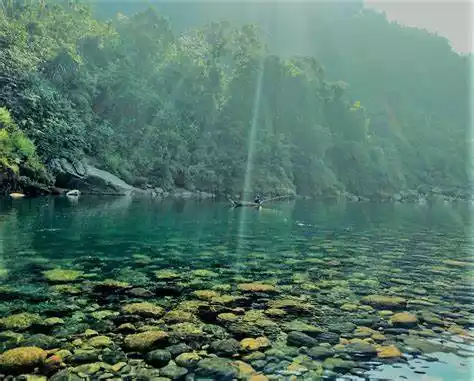Comprehensive Guide to the District West Jaintia Hills
Introduction
Nestled in the northeastern region of India, West Jaintia Hills is a district in the state of Meghalaya, renowned for its lush landscapes, vibrant culture, and historical significance. This article delves into the rich tapestry of the district, exploring its demography, culture, geography, topography, cuisines, history, notable poets and authors, and administrative framework.
Demography
West Jaintia Hills is predominantly inhabited by the Jaintia tribe, an indigenous ethnic group with a rich cultural heritage. The population also includes smaller communities such as the Pnar, War, and Bhois. The district is characterized by a young demographic profile, with a significant portion of the population engaged in agriculture, mining, and small-scale industries. The literacy rate is relatively high, with a strong emphasis on education among the local communities.
Culture
The culture of West Jaintia Hills is a vibrant amalgamation of traditional practices, folklore, and contemporary influences. The Jaintia people are known for their elaborate festivals, music, and dance forms. One of the most prominent festivals is Behdienkhlam, a post-sowing festival celebrated with fervor and traditional rituals aimed at driving away plague and misfortunes. The festival features colorful processions, traditional dances, and symbolic rituals that reflect the rich cultural ethos of the Jaintia people.
Traditional crafts such as weaving, bamboo work, and pottery are integral to the district's cultural identity. Handloom textiles, known for their intricate designs and vibrant colors, are particularly noteworthy.
Geography and Topography
West Jaintia Hills is characterized by its picturesque landscapes, comprising rolling hills, dense forests, and flowing rivers. The district lies within the Meghalaya Plateau, which is part of the larger Shillong Plateau. The terrain is predominantly hilly with an average elevation of 1,200 meters above sea level.
Key Geographical Features
- Myntdu River: A significant river in the district, the Myntdu River is not only a vital water source but also a scenic attraction.
- Thadlaskein Lake: A man-made lake with historical and cultural significance, surrounded by lush greenery.
- Nartiang Monoliths: A collection of monolithic structures that stand as a testament to the region's historical and cultural past.
Topography
The topography of West Jaintia Hills is a blend of undulating hills, fertile valleys, and plateau regions. The district's unique landscape includes limestone caves, the most famous being the Syndai and Umlawan caves, which are popular among spelunkers and tourists. The limestone deposits in the region have also fostered a thriving cement industry.
Cuisines
The culinary traditions of West Jaintia Hills are deeply rooted in the local culture and the availability of regional ingredients. The diet is predominantly rice-based, complemented by a variety of meat, fish, and vegetables. Some of the district's signature dishes include:
- Jadoh: A fragrant rice dish cooked with pork, often served with spicy chutneys.
- Pukhlein: A traditional snack made from rice flour and jaggery, deep-fried to perfection.
- Dohneiiong: Pork cooked with black sesame seeds, offering a unique flavor profile.
- Tungrymbai: Fermented soybean paste cooked with pork and spices, a staple in local cuisine.
Indigenous beverages like rice beer (Kyat) and local brews made from millet and maize are also popular among the Jaintia people.
History
The history of West Jaintia Hills is rich and multifaceted, with the Jaintia Kingdom being one of the prominent historical entities in the region. The kingdom's origins trace back to the pre-colonial era, with its rulers known for their administrative prowess and military strategies.
Historical Milestones
- Jaintia Kingdom: The kingdom flourished until the mid-19th century, with its capital at Jaintiapur (now in Bangladesh). The kingdom was known for its strategic trade routes and cultural richness.
- British Colonization: The British annexation of the Jaintia Kingdom in 1835 marked a significant turning point, leading to administrative and socio-economic changes.
- Post-Independence: After India's independence, the region underwent administrative reorganization, eventually forming part of the state of Meghalaya in 1972.
Notable Poets and Authors
West Jaintia Hills has produced several literary figures who have contributed significantly to the cultural and intellectual landscape of the region.
Prominent Literary Figures
- Sosotemka Sumer: A renowned poet known for his works in the Pnar language, capturing the essence of Jaintia culture and traditions.
- Ramekupar Massar: An author and historian whose works provide valuable insights into the history and folklore of the Jaintia people.
Administration
The administrative structure of West Jaintia Hills is designed to ensure effective governance and development. The district is divided into several administrative blocks, each managed by elected representatives and officials.
Key Administrative Divisions
- Deputy Commissioner: The head of the district administration, responsible for overseeing various governmental functions and development programs.
- Sub-Divisional Officers: Officials managing specific subdivisions within the district, ensuring localized governance.
- Block Development Officers: Key figures in implementing rural development schemes and programs at the block level.
Development Initiatives
The district administration has launched several initiatives aimed at improving infrastructure, healthcare, education, and socio-economic conditions. Programs focusing on sustainable agriculture, tourism development, and skill training are pivotal to the region's growth.
Conclusion
West Jaintia Hills stands as a beacon of cultural heritage, natural beauty, and historical significance. The district's rich tapestry of traditions, diverse landscapes, and vibrant community life make it a unique and compelling destination. As we continue to explore and appreciate the myriad facets of West Jaintia Hills, we are reminded of the enduring legacy and dynamic spirit that define this remarkable region.
